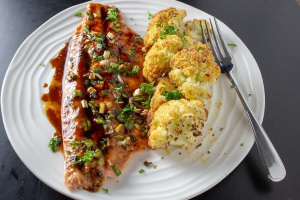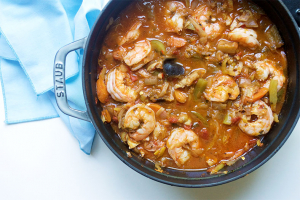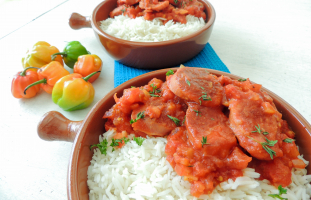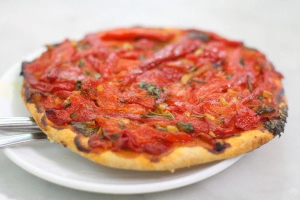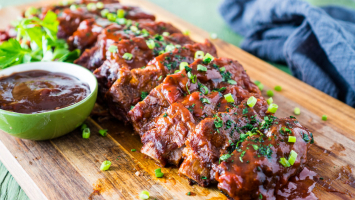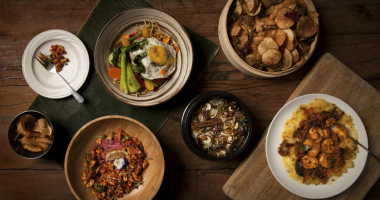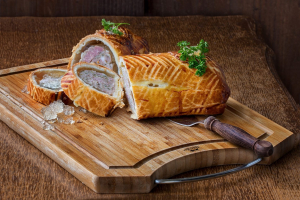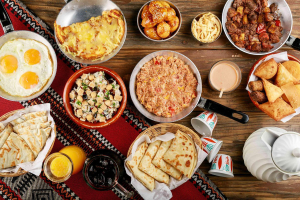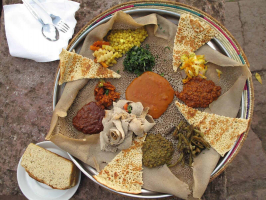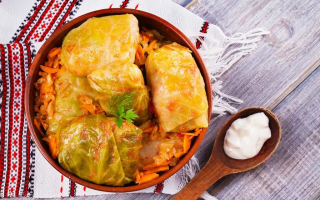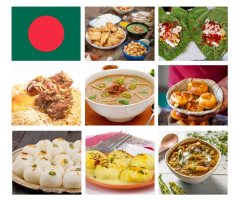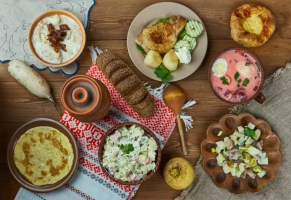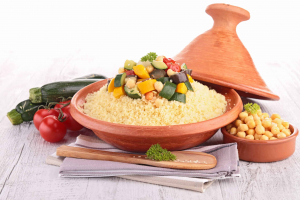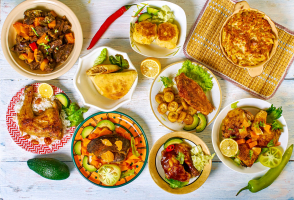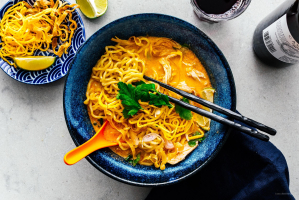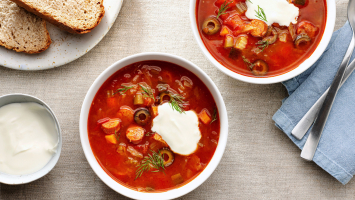Top 10 Best Foods In Slovenia With Recipe
If you're visiting Slovenia for the first time and want to experience Slovenian food, you're in for a treat. Whether you're a foodie looking to try something ... read more...new or want to add a little Slovenian flair to your home cuisine. The article is the list of top 10 best foods in Slovenia with recipe that you should not miss.
-
The original recipe for cooked struklji with tarragon filling is supposed to have been written down in 1589 by a chef at a mansion in Graz. In the 17th century, they became a festive dish for the urban middle class, and two centuries later, they extended to rural households. They were introduced into ordinary cuisine during the turn of the twentieth century.
Struklji ranks first in the list of the best foods in Slovenia with recipe. It is a traditional Slovenian cuisine that consists of various types of rolled dough filled with either savory or sweet ingredients such as cottage cheese, walnuts, apples, and poppy seeds. They can be seen all around Slovenia, in homes, restaurants, and mountain cabins. Struklji can be baked or cooked, and one particular variation is popular in the spring and summer, when struklji are stuffed with fresh tarragon. Originally, the meal was cooked at celebrations and festivities to commemorate the conclusion of hard labor on the farms, and the practice continued until the 1930s, when people began cooking struklji all year.
Ingredients
- For the dough: ½ cup hot tap water2 tablespoons butter1 egg, lightly beaten1 teaspoon salt, if desired2 cups all-purpose flour
- For the filling: 4 tablespoons butter1 cup bread crumbs4 eggs1 pound dry cottage cheese½ cup sour cream1 tablespoon chopped parsley Salt to taste, if desired
- For the topping: 1 cup bread crumbs4 tablespoons butter
Instructions
- To make the dough, place the hot water in a small bowl and add the butter to the water to melt. With a fork, blend in the egg and salt.
- Place the flour in a separate mixing bowl. Make a well in the flour and pour in the liquid mixture. Blend and knead until the resulting dough is smooth and elastic. Cover and allow to rest in a draft-free place for about 30 minutes.
- Meanwhile, prepare the filling by melting the butter in an 8-inch saucepan and browning the bread crumbs in it.
- Remove from the heat, add the eggs and stir until they have completely scrambled.
- Combine the cottage cheese, sour cream, parsley and salt in a mixing bowl. Add the egg mixture and mix well.
- Roll the dough on a lightly floured board into a rectangle about 12 inches by 18 inches. Spread the filling over the dough and roll it, starting at its long side, into a tight roll, much like a jellyroll.
- Place the roll on a clean white cloth or a double thickness of cheesecloth large enough to cover it. Wrap the roll in the cloth and tie the ends with string, sausage fashion.
- Coil the roll into a circle and drop it into a large pot of boiling salted water. Simmer for 40 minutes, then carefully lift it from the pot. Unwrap the roll and keep it warm.
- For the topping, sauté bread crumbs in butter until golden brown. Slice the struklji into pieces 2 inches thick and top with the buttered crumbs.
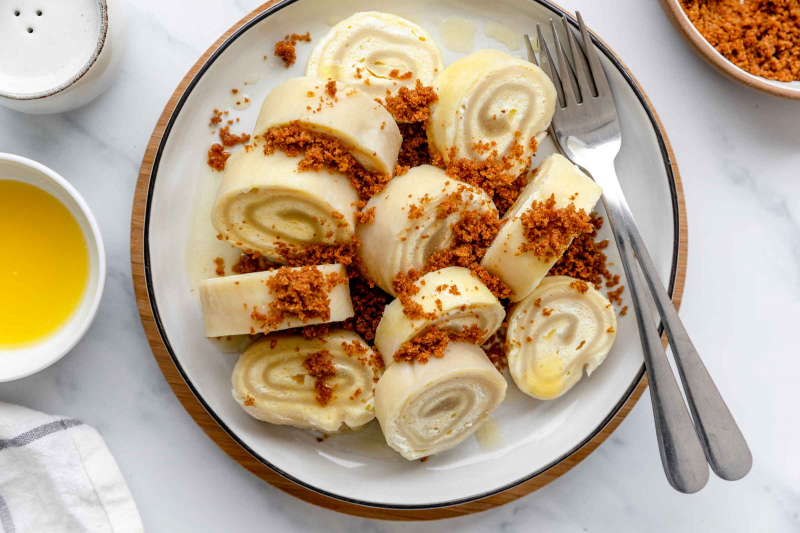
jernejkitchen.com 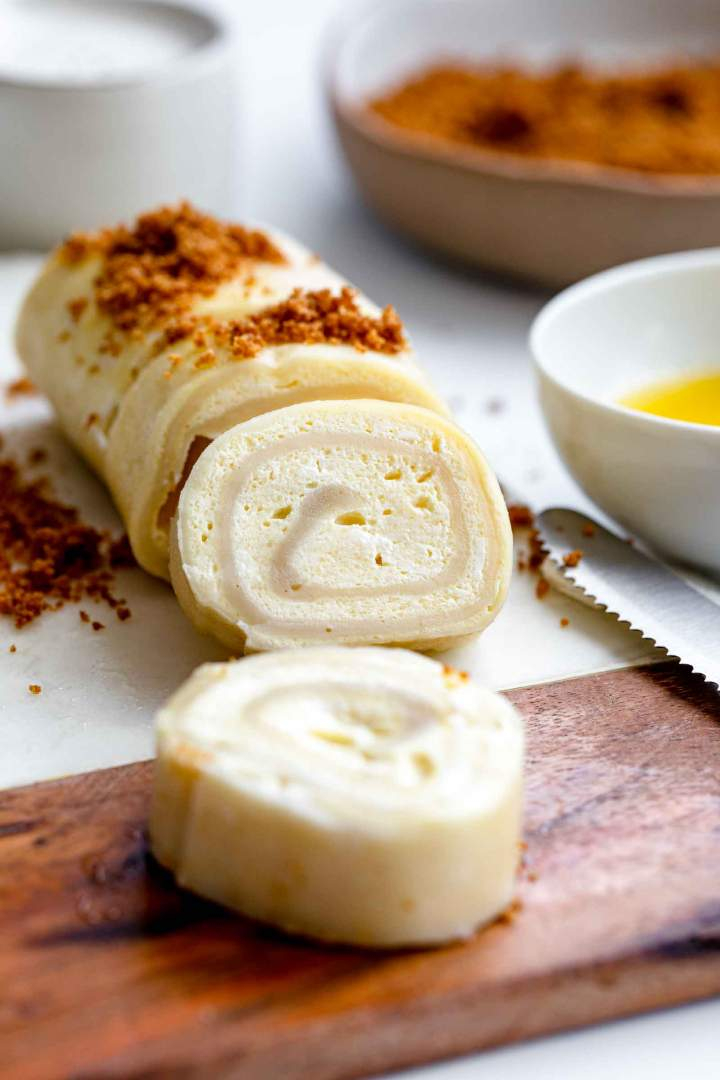
jernejkitchen.com -
Potica, a traditional cake that is frequently created for festivities and events such as Christmas and Easter, is widely regarded as every Slovenian housewife's source of pride. Potica is a Slovenian name that evolved etymologically from earlier Slovenian forms such as povitica, povtica, and potvitsa. This is also related to the evolution of potica production processes from the Middle Ages (before the 15th century) until the beginning of the 20th century, when development stabilized and unique potica nomenclature was formed beginning in the 18th century. Slovenian potica has been used since the second part of the nineteenth century.
The cake evolved from older rolled dough cakes and was first referenced in 1575. Originally restricted for the aristocratic class, it has acquired appeal among peasants over the years. Potica comes in over 60 different varieties, with typical fillings such as walnuts, hazelnuts, tarragon, honey, poppy seeds, and cottage cheese. Potica is now available with chocolate as a filling. This dish is so important in Slovenian cuisine that it has appeared on two Slovenian postage stamps. The cake is now available in stores and various Slovenian restaurants, although it is considered that homemade potica is still the tastiest.
Ingredients
- 1 ½ teaspoons active dry yeast, ¼ cup white sugar, ¼ cup milk, lukewarm, 1 cup butter, softened, 6 egg yolks, 1 ⅓ cups milk, 5 cups all-purpose flour, 1 teaspoon salt, 1 cup butter, melted, 1 cup honey, 1 ½ cups raisins. 1 ½ cups chopped walnuts, 1 tablespoon ground cinnamon
Instructions
- In a small mixing bowl, dissolve yeast, 1 teaspoon sugar, and 3 tablespoons of the flour in warm milk. Mix well, and let stand until creamy, about 10 minutes.
- In a large mixing basin, beat together the butter and remaining sugar. One at a time, add the egg yolks, beating vigorously after each addition. Mix in the yeast mixture, remaining milk, 4 cups of flour, and salt. Stir in the remaining flour, 1/2 cup at a time, until thoroughly combined. When the dough has pulled together, turn it out onto a lightly floured surface and knead for 8 minutes, or until smooth and elastic. Lightly oil a large mixing bowl, then add the dough and turn to coat with oil. Cover with a moist towel and set aside in a warm place to rise for 1 hour, or until doubled in volume.
- Grease one or two cookie sheets lightly. Turn the dough out onto a lightly floured surface to deflate it. Divide the dough into two equal pieces and roll out to a thickness of 1/4 to 1/2 inch. Spread melted butter, honey, raisins, walnuts, and cinnamon on each slice. Roll each piece into a jelly roll and pinch the ends together. Place the baking sheets, seam side down, on the prepared baking sheets. Allow to increase until the volume has doubled. Preheat the oven to 350°F (175 degrees C).
- Bake at 350 degrees F (175 degrees C) for about 60 minutes or until the top is golden brown.
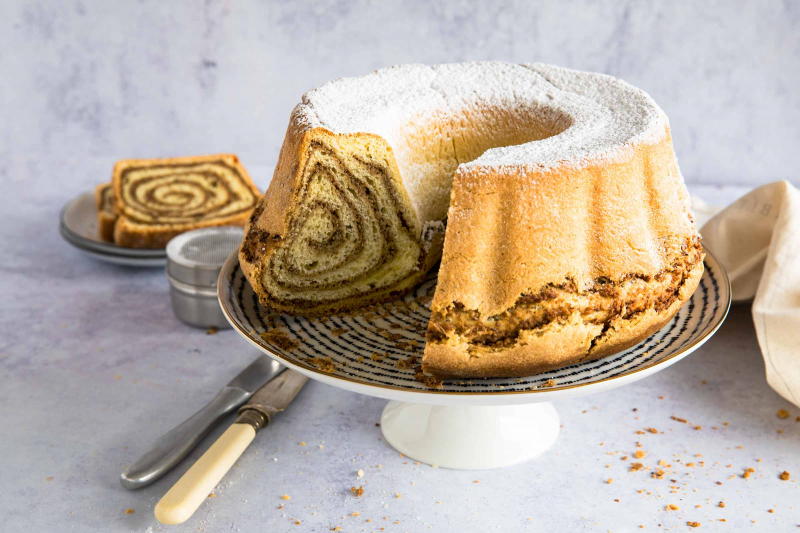
thespruceeats.com 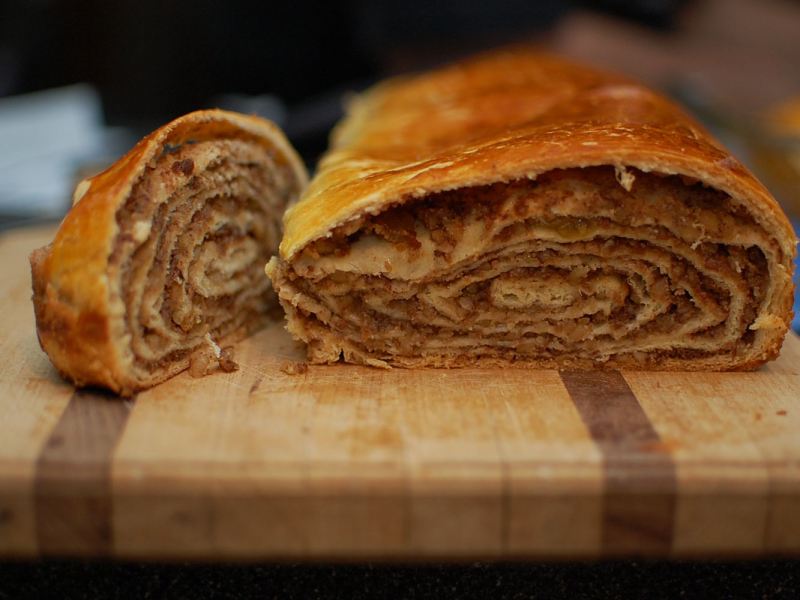
jernejkitchen.com/recipes/nuts/potica -
Kremna rezina is a Slovenian Lake Bled specialty. It's a decadent cream cake with a golden, crispy, buttery pastry base. The base is covered with a layer of thin, buttery dough and fragrant vanilla custard. Traditionally, the entire cake is sprinkled with icing sugar and served in cubes. The origins of kremna rezina (or Bled cream cake) may be traced back to the arrival of chef Itvan Lukaevi to Bled's Park Hotel, where he modified the Hungarian cream cake by adding the proper proportions of whipped cream, and the hotel unveiled Lukaevi's invention to the public in 1953.
With up to 3,500 slices sold per day, the novel dessert was a big success and became a favorite tourist treat. The true kremna rezina is more than just a cake; the pastry is claimed to be folded seven times before being set aside, the custard is cooked for exactly seven minutes, and each cake is cut into a seven-by-seven centimeter square.
Ingredients
- 2 layers of puff pastry, already rolled, 6 large eggs, 150 g (3/4 cup or 5.3 oz) white sugar for egg yolk mixture, 50 g (1/4 cup or 1.8 oz) white sugar for egg white mixture, 1 tsp rum, 700 ml (3 cups or 23.7 fl. oz) whole milk for cooking, 100 ml (1/2 cup or 3.4 fl. oz) whole milk for egg yolk mixture, 10 g (0.3 oz) vanilla sugar, 100 g (1/2 cup + 1/8 cup or 3.2 oz) strong bread flour, 2 tbsp corn starch, 500 ml (2 cups or 17 fl. oz) whipping cream, 2 tbsp caster sugar, Caster sugar, Baking pan with removable sides, 24x24x7 cm (9.5x9.5x2.8 inches), Large whisk
Instructions
- Remove puff pastry from freezer and let it rest, still wrapped, for 20 minutes at room temperature. While it rests, flour your work surface.
- Roll out puff pastry to a 12 x 15 rectangle. Trim the edges to be even, then prick the dough all over with a fork. Cut lengthwise into two rectangles, each one 6 inches wide.
- Place both pastries on a large parchment-lined baking sheet. Score one pastry into ten squares (divided lengthwise into two rows of five), being sure to not cut all the way through. Chill pastry in the refrigerator for 30 minutes.
- Make the pastry cream: Slowly bring milk and lemon peel to a boil in a heavy pan. Lower the heat and remove the peel.
- Whisk eggs yolks and 1 Tbsp of sugar in a bowl until pale and smooth, then stir in the flour.
- Whisk the hot milk into the flour and egg mix, then return all to the stovetop pan.
- Over low heat, stir constantly until the mix forms a thick custard. Pour into a bowl and let it cool a little, but not until firmly set.
- Whisk the egg white with the remaining 3 Tbsp of sugar until stiff peaks form.
- Whip 2/3 cup of the cream (reserving the remainder) until thick.
- Stir rum into the custard, then fold the egg white mixture gently with a spatula, followed by the whipped cream. The combination is your pastry cream. Chill for 30 minutes until fully set.
- Remove baking sheet from the fridge and moisten the area around the pastry, then bake the pastry for 25 minutes (until golden and flaky). Cool.
- Make the whipped cream: Sift 1 Tbsp confectioner’s sugar into the remaining heavy cream and stir in the vanilla. Whip.
- Put the unscored pastry on a dessert tray, spread with the pastry cream, and then spread the whipped cream atop that. Lay the scored pastry over the whipped cream, and dust with the remaining confectioner’s sugar. Slice along the scoring and serve.
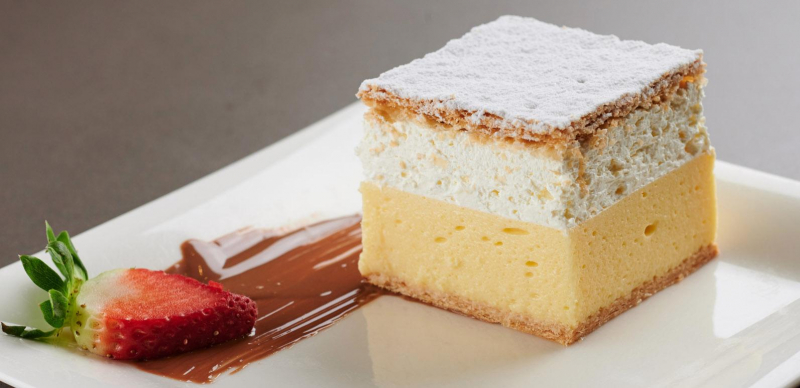
the-slovenia.com 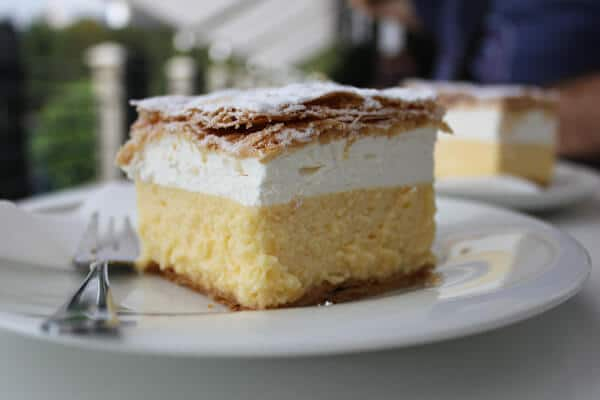
tasteatlas.com - 2 layers of puff pastry, already rolled, 6 large eggs, 150 g (3/4 cup or 5.3 oz) white sugar for egg yolk mixture, 50 g (1/4 cup or 1.8 oz) white sugar for egg white mixture, 1 tsp rum, 700 ml (3 cups or 23.7 fl. oz) whole milk for cooking, 100 ml (1/2 cup or 3.4 fl. oz) whole milk for egg yolk mixture, 10 g (0.3 oz) vanilla sugar, 100 g (1/2 cup + 1/8 cup or 3.2 oz) strong bread flour, 2 tbsp corn starch, 500 ml (2 cups or 17 fl. oz) whipping cream, 2 tbsp caster sugar, Caster sugar, Baking pan with removable sides, 24x24x7 cm (9.5x9.5x2.8 inches), Large whisk
-
Krapfen ranks 4th in the list of the best foods in Slovenia with recipe. If the term 'Krapfen' confuses you, it's conceivable you're familiar with these German doughnuts as Berliner. They are well-liked throughout the German-speaking world. In Austria and southern Germany, they are known as Krapfen, while in northern Germany, they are known as Berliner/ Pfannkuchen/ Berliner Pfannkuchen/ Kreppel. This may appear to be perplexing because, in some parts of Germany, Pfannkuchen also means German crepes, despite the fact that they are plainly not the same thing. They are sometimes referred to as Faschingskrapfen in Austria because they are most commonly consumed during Fasching, however they can be bought at any grocery store or bakery all year round. Fasching is similar to Mardi Gras in the United States and occurs before Lent.
Traditionally, these pastries are made with leavened dough that is deep-fried till golden and crispy on the exterior while remaining soft, light, and airy on the interior. Though krapfen can be served simple, they are most commonly filled or topped with jams, vanilla or chocolate custards, and powdered sugar or chocolate poured on top. The term krapfen dates back to the ninth century, and recipes in German can be found as early as the 14th century. Sweet variations of the pastry became popular, and they have remained intimately associated with Carnival, the joyful month preceding Christian Lent. During the Carnival, one krapfen in a batch filled with jam and fruit preserves may contain a mustard filling as a prank.
Ingredients
- 1 package yeast, 2 cups of milk4 egg yolks, 1 whole egg, 1/2 cup sugar, divided, 1/2 cup butter, Lemon rind, 7 cups flour divided, 1 teaspoon salt, 1 teaspoon vanilla
Instructions
- Crumble yeast in water; stir in sugar and 2 tablespoons flour. Set aside to rise, about 10 minutes. Meanwhile, heat milk, half and half, butter and margarine; cool to lukewarm. In large bowl, beat eggs, sugar, salt and sour cream together.
- Add milk mixture to egg mixture.
- Stir in yeast, lemon rind, juice and 2 cups flour. Beat until smooth.
- Mix in enough remaining flour until dough is easy to handle, about 7 cups.
- Place on floured board and knead about 10 minutes to a soft non-sticking dough, adding more remaining flour on board as needed.
- Place in greased bowl, turn to grease top. Cover and let rise until doubled, about 1-1/2 to 2 hours.
- On lightly floured cloth, place dough and stretch (no rolling) to 1/2-inch thickness. Cut rounds (there are no holes in krofe) with the top of a glass or with a doughnut cutter (removing inner cutting circle).
- Place rounds on floured cloth; cover with a cloth to rise about 30 minutes or until light.
- Use scraps of dough to make additional rounds.
- Fry in deep fat (3 inches of oil) until golden brown on both sides, turning once.
- Place on brown paper to absorb fat.
- Dust with powdered sugar when krofe are cooled.
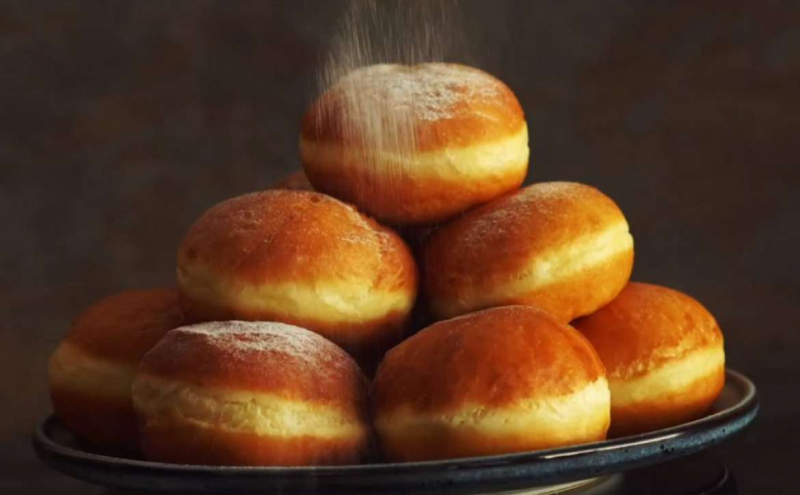
e-slovenie.com 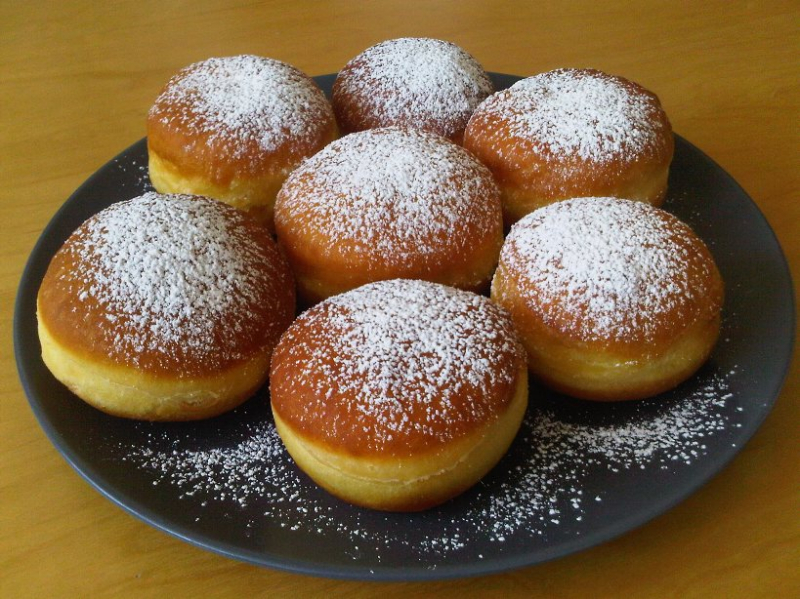
stefkinedobrote.si -
The cuisine of Idrija is known for the fact that it has managed to create priceless culinary pearls from selected, high-quality and locally available ingredients. The most recognizable are the Idrija žlikrofi with the national and European label Guaranteed traditional specialty, and every Idrija meal definitely includes smutkavac and ocvirkovca. This popular pasta dish is a type of ravioli that is traditionally cooked in western Slovenia, specifically the town of Idrija. Zlikrofi are prepared with two layers of thin pasta dough wrapped around the filling, and its real potato filling is even more distinctive than their attractive design like a bicorne hat.
Except for minor modifications in the filling, the recipe for this delectable Slovenian dish hasn't altered considerably throughout the years. The first documented evidence is from the 1936 book Nas Idrijski Kot, in which the author tells how the popular zlikrofi were only prepared on rare occasions, usually with potatoes, pork, or turnip mash.
Ingredients
- 300 g flour, 1 egg, 60 ml water, 60 ml milk, 2 tbsp oil, 500 g old dense potatoes, 50 g bacon (bacon be replaced by pork cracklings), 50 g onion, 1 bunch chives, 1 bunch marjoram, salt, pepper to taste
Instructions
- Mix all the ingredients for the dough by hand or using a food processor. The dough should be smooth and elastic with no air bubbles and softer than the pasta dough. Cover it with plastic wrap and let rest for at least 30 minutes.
- Cook the potatoes for about 25 minutes until they are completely done and rice them while still warm.
- In a pan, fry diced bacon, and union until the bacon is crisp. Finely chop chives and marjoram.
- Add bacon, onion and the herbs to potatoes and mix. Add salt and pepper to taste.
- Form nut sized balls from the filling. If the potato mixture is sticky, moistening your hands with water helps.
- Roll out the dough as thinly as you can. You can also use the pasta machine using the lasagna slot for this step.
- Cut the rolled out dough so you get a straight line and then place the balls along the edge. There should be about one finger of space between them.
- Roll the dough around them until the potato balls are covered. Cut the line off with a knife.
- Press down between the balls with your finger so that the mixture does not escape while cooking.
- Cut along the middle between each pair of balls.
- Shape the žlikrofi: press the rims together to form the 'ears' of the dumpling, and then use your thumb to form a dimple on the top of it. Keep the dumplings apart from each other on a floured surface.
- Boil a pot of water and cook the žlikrofi until they float to the surface.
- Žlikrofi are usually served either with 'bakalca', mutton sauce, pork cracklings or drizzled with lard and sprinkled with chives.
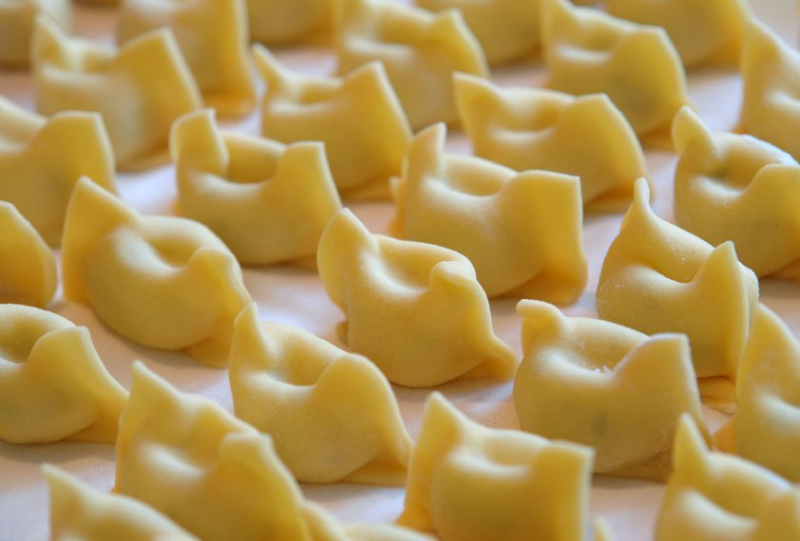
vandraj.si 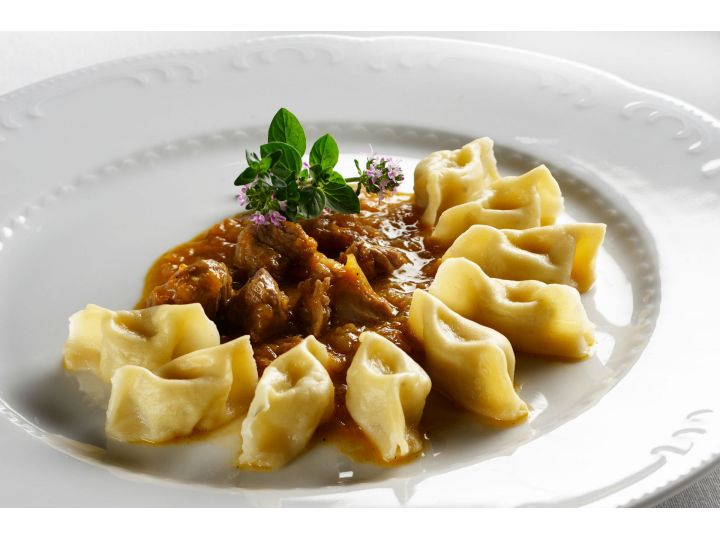
arhiv.gorenjskiglas.si - 300 g flour, 1 egg, 60 ml water, 60 ml milk, 2 tbsp oil, 500 g old dense potatoes, 50 g bacon (bacon be replaced by pork cracklings), 50 g onion, 1 bunch chives, 1 bunch marjoram, salt, pepper to taste
-
Prekmurska gibanica ranks 6th in the list of the best foods in Slovenia with recipe. Prekmurska gibanica, which mixes the flavors of poppy seeds, cottage cheese, apples, and walnuts, is one of Slovenia's most recognized delicacies. This treat from a nearby neighborhood is one of the most decadent desserts you can imagine, and it will not disappoint. The ingredients listed above serve as the foundation for four distinct and delectable fillings. Because each filling is repeated even twice, it is apparent that the Prekmurje gibanica is a truly unique cake with its unusual dimensions, and it looks stunning when presented on the table.
Each layer should be topped with sour cream and melted butter, and this second item is used to coat the crust, which separates the layers. There is a thin layer of shortcrust pastry at the bottom, which allows them to achieve nine stunning layers, as many as this certainly high-calorie cake has. This dish will remind many people of the equally delicious Croatian cake Meimurska gibanica, which they shared on the site a few years ago. Both desserts share many similarities, but there are a few key distinctions, including a varied number of layers, a shortcrust pastry foundation, and the usage of cottage cheese. But, while each layer in both recipes is distinct and distinct, they all come together in a harmonious whole that please even the most discerning dessert connoisseurs.
Ingredients
- 1 pound apples, peeled, cored, and grated, 7 ounces sugar, 1/2 teaspoon cinnamon, 1 tablespoon lemon juice, 1/2 cup bread crumbs, dry, 1/2 cup raisins, soaked in 2 tablespoons dark rum, 2 tablespoons dark rum, for the raisins, 1 pound cottage cheese, dry curd, 1 1/2 cups sour cream, 7 ounces sugar, 1 teaspoon vanilla extract, 14 ounces poppy seeds, ground in a or mortar and pestle, 7 ounces sugar, 1/2 cup milk, hot, 1 pound walnuts, 7 ounces sugar, 2 tablespoons milk, 2 large eggs, beaten, 1/2 cups sour cream, 2 tablespoons sugar, 1 pound filo dough.
Instructions
- Gather the ingredients.
- Mix the ingredients for each of the fillings in separate medium bowls until they are moist and spreadable, and set aside. Mix the sour cream topping ingredients in a medium bowl and set aside.
- Heat oven to 350 F. Lightly brush the bottom and sides of a 10-inch springform pan with some of the melted butter. Place 2 sheets of filo dough in the bottom and up the sides of the pan, letting it overhang (this will be cut off later). Lightly brush with butter and lay down two more sheets of filo dough and brush those with butter.
- Spread half the poppyseed mixture on the dough and lay two sheets of filo dough on top of it. Brush with butter and spread half the cheese filling on top followed by two more sheets of filo dough. Butter them and spread half the walnut filling on top. Lay down two more sheets of filo dough, butter them and spread with all the apple filling.
- Now repeat by laying down another two sheets of filo dough, buttering them and spread the remaining poppyseed filling on top. Continue in this manner until you have spread on the remaining portion of walnut filling.
- Lay down two sheets of filo dough and butter them. Place two final sheets of filo dough down and butter them. Cut off any hanging filo dough. (Use any leftover filo dough for appetizers or mini tarts.) Spread the sour cream topping over the gibanica. Place pan on a baking sheet. Using a long skewer, pierce the gibanica all the way to the bottom in several places. Bake 1 hour or until top is golden brown. If top is browning too fast, cover with aluminum foil.
- Store refrigerated, but serve at room temperature for best flavor.
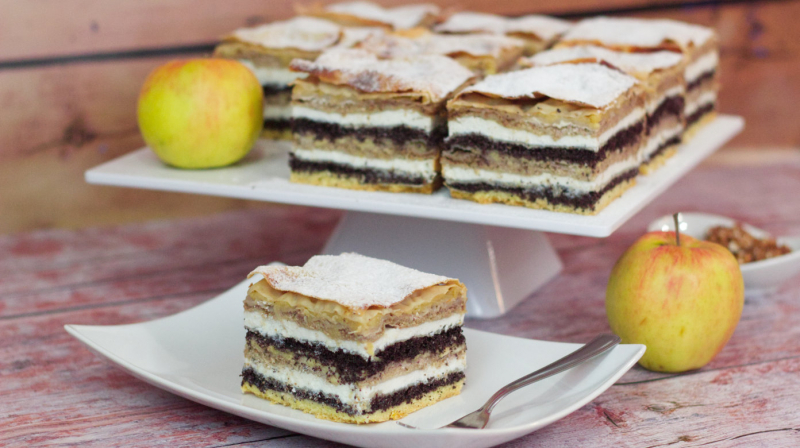
recepttura.com 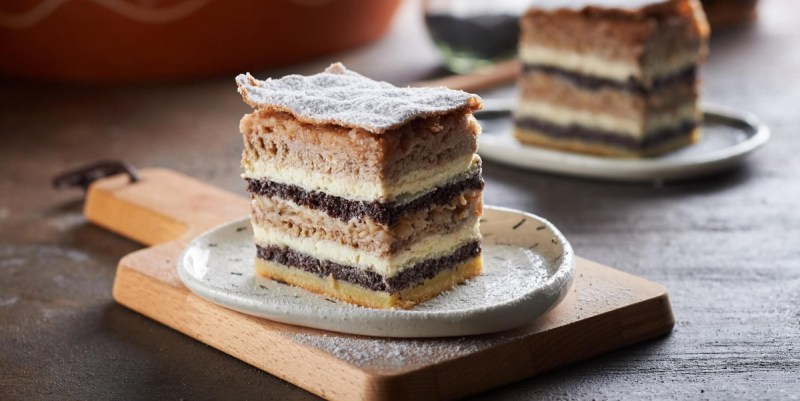
recepttura.com -
Frtalja (it. Frittata, sometimes egg omelet) is a basic rustic Slovene cuisine. It is an egg dish that is particularly known in Primorska cuisine. In other regions of Slovenia, it is known as an omelet, kaiserschmarrn, or pancake, although frtalja is distinct from all three. Omelets and pancakes are thin and spread, while kaiserschmarrn is a shredded pancake, although neither dough contains herbs.
Frtalja is shaped like a cake and is about 3 centimeters tall. The dough is mixed with herbs, vegetables, or dried meat (sliced sausage or prosciutto). Frtalja was once a required dish on May 1st (Volji grad, Temnica), possibly due to the superstition that first frtalja chases vipers away. Fennel is commonly used in the first frtalja.
Today, frtalja are a part of the catering menu since they are quick to prepare, juicy, flavorful, and vary in flavor. It can be served as an appetizer alongside cold cuts, as a standalone meal with a sauce, or as a side dish alongside the roast. It is typically consumed as a hearty snack or as a travel ration on longer excursions and hikes.Ingredients
- 3 eggs, ca 5 Tsp whole wheat flour (add more if needed), 50 ml sparkling water, 1 bundle of cilantro, 2 green chilis, 2 spring onions, a handful of dill, half a bundle of chives, 2 Tbsp of parmesan pieces, salt and pepper
Instructions
- To begin, take a bowl and beat the eggs in it. Add the sparkling water, salt and pepper. Then, add the flour, little by little. Use a hand mixer to combine the ingredients well together. Continue mixing until smooth, slightly thick but not runny.
- Furthermore, wash and drain all the greens (cilantro, spring onions, chilis, dill and chives) that goes in the frtalja. At this point, roughly chop them and stir them into the batter and give it a stir to combine all the ingredients.
- Prepare a big frying pan and heat some oil in it. Only when the pan gets hot, pour in half of the mixture. You can do a test with one drop of the mixture. If there are some small bubbles around it, it is ready.
- Pour the mixture into the pan and by tilting the pan, spread the batter around it (just like you would do with a pancake). Then, add some parmesan pieces and cover for a couple of minutes. Once the batter gets firmer and starts to “dry”, it is time to turn it around. Carefully but quickly flip it over and cook for another 3 minutes or till golden brown.
- Finally, transfer the frtalja to a cutting board or plate and cut it into triangles. You can serve it either warm or cold, which makes it a great snack as well. Also, it pairs well with a yogurt dip or any other refreshing dip of your choice.
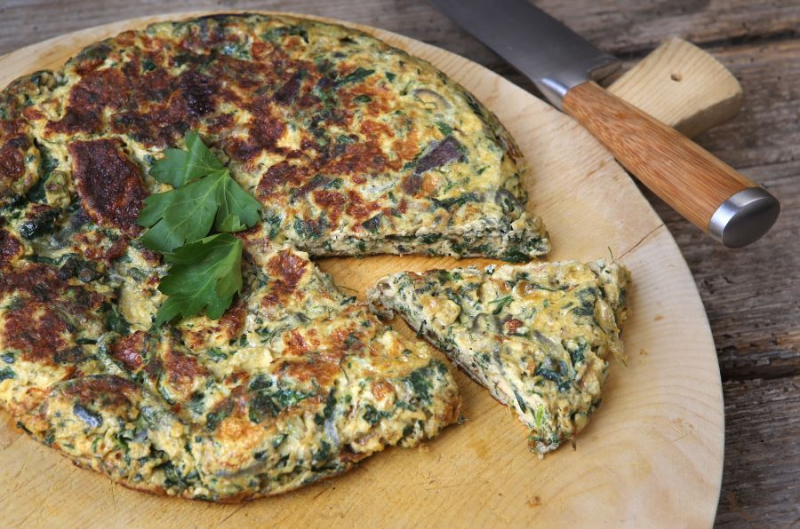
odprtakuhinja.delo.si 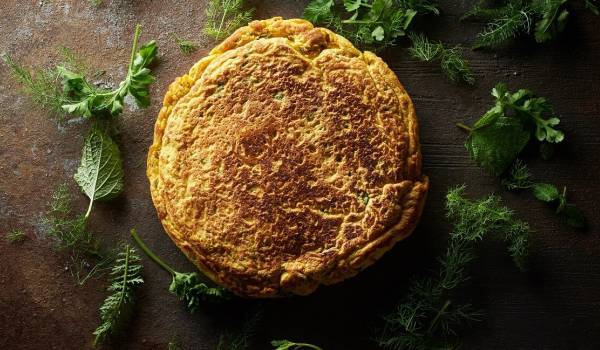
odprtakuhinja.delo.si -
Kranjska klobasa, also known as Carniolan or Krainer sausage, comes from the historical territory of Kranjska, which was originally the Duchy of Carniola, a crown land of the Austrian Empire. It has the ideal meat-to-bacon ratio: at least 80% coarsely ground good-quality pork pieces (leg, shoulder, neck) and 20% bacon (back fat), seasoned with Seovlje saltern salt, black pepper, and garlic. After stuffing the meat mixture into natural casings, the sausages are twisted into links, knotted, and fastened together with a wooden stick. After that, the links are pasteurized and hot-smoked until they attain a medium reddish-brown hue.
The sausage can be eaten with mustard, ketchup, and a slice of dark bread, or as a Käsekrainer-Hot-Dog, which is the most common variant in Austria. (By Hot Dog, Austrians refer to the bun rather than the sausage.) The bread used is comparable to a French baguette, but it is shorter (200 to 250 mm (7.9-9.8 in) long, has a distinct texture, and is not called a baguette, but a bun. A warm 1-inch-diameter (25 mm) metal rod is used to poke a hole in the bun at one end. The next step is to fill the hole with sauce. Austrians typically choose amongst three sauces: harsh mustard, sweet mustard, and ketchup.
Ingredients
- 4 1/2 pounds pork shoulder, coarsely ground, 6 cloves garlic, crushed, 1/2 cup white wine, 1 tablespoon freshly ground black pepper, or to taste, 2 tablespoons salt, 1 tablespoon saltpeter, optional, 1 cup cold water, 8 ounces hog casings, approximately, 1 tablespoon sweet paprika, optional, 1 cup finely chopped onions, optional, 4 slices bread, torn, optional
Instructions
- Soak crushed garlic in wine overnight. Soak casings in lukewarm water about 6 hours.
- In a large bowl, mix ground pork, pepper, paprika, salt, saltpeter (if using), garlic-wine mixture, and onion and bread. Add water and mix well. Cover with plastic and refrigerate for several hours for the flavors to meld. Remove from refrigerator and mix by hand again. Fry up a small patty to make sure the seasonings are to your liking.
- Take casings out of the water and rinse several times by letting cold water run through the casing. Fill casings with meat mixture, being careful not to leave air pockets. Twist into uniform lengths. Smoke the sausages for two to three days. Fresh sausage may be pan-fried or roasted in the oven.
- To prepare sausage you have smoked, place in cold water and bring to a boil. Remove from heat, cover and let sit in hot water for 10 minutes. Drain and serve.
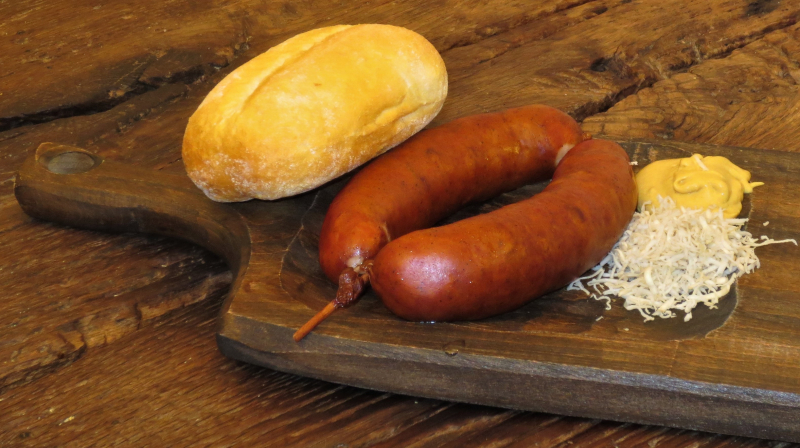
istockphoto.com 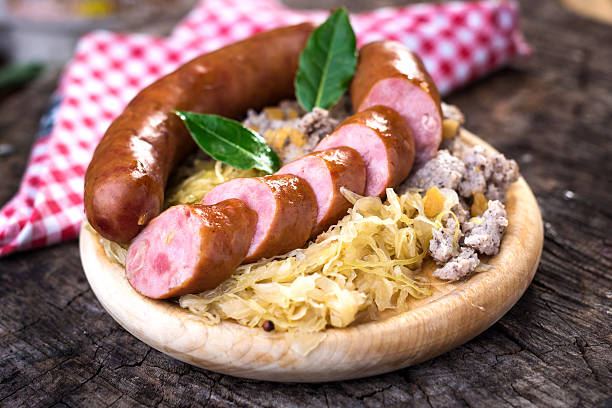
en.wikipedia.org -
Bujta Repa must be included on any list of the top Slovenian lunch meals. The name may raise some eyebrows: Repa means "turnip," whereas Bujta implies "kill" or "slaughter"! Actually, the latter relates to the fact that villagers obtain supplies for cooking it from slaughterhouses. Bujta Repa is a spicy stew made with grated pickled turnip, spices, and various pig parts like the head, skin, or neck. Additionally, boiling beans and a generous amount of lard are required for the stew to obtain its fatty, wintertime-enduring reputation. It is typically served with millet.
High-quality Bujta Repa should not have had any steam in the past. It has to be chilly and oily as well. Needless to say, the practice has long since passed. Slovenians in Prekmurje, the northeastern region, first came up with the dish as a way to survive winter. Today, some vegetarian recipes replace fatty, meaty ingredients with wholesome plant-based stuff. Anyway, the stew is still a wonderful option to spend your winter.Ingredients
- 1000 grams of sauerkraut, 800 grams of pork meat, 40 grams of flour, 300 grams of millet seeds, Two cloves of garlic, One mid - sized onion, Canola oil, Salt and pepper
Instructions
- Let the meat with turnip boil lightly together and cook.
- When you see that the meat is almost soft, add the unmade porridge.
- Add bay leaf and salt (according to your taste, usually 2 teaspoons).
- Mix the oil and flour and add chopped onion and garlic.
- Pour over a bit of cold water and mix, then stir it all in with the meat and turnip.
- Add it to boiling again and add salt
- Take out the meat and cut it into slices
- You can serve the turnip in a bowl with the slices on top
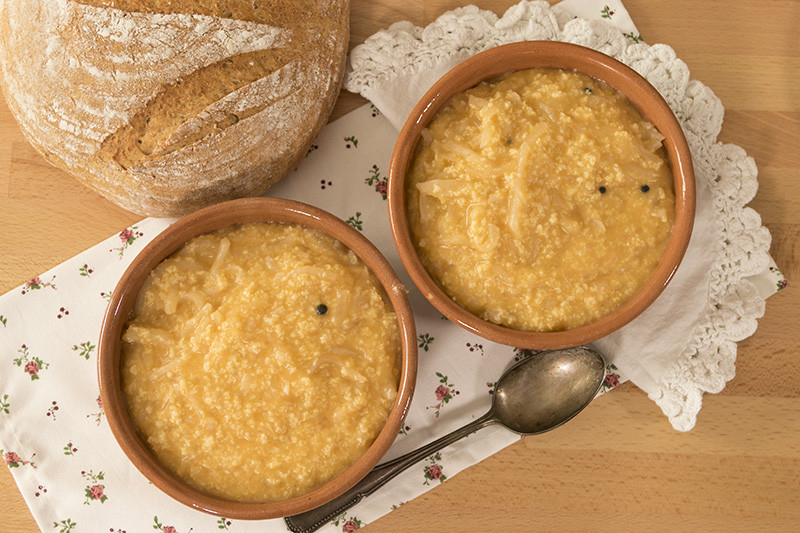
cookpad.com 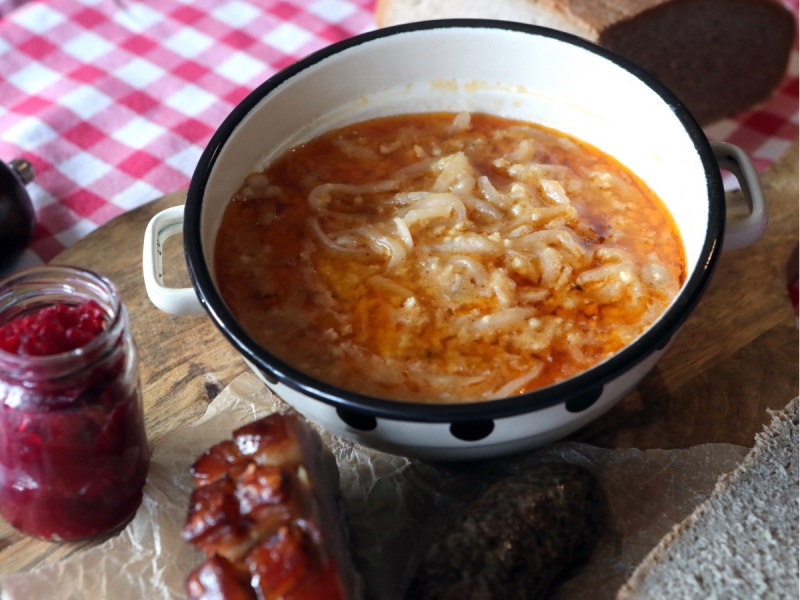
tasteatlas.com -
This salad is formed from young and soft dandelion leaves and filled with hard boiled eggs, fried potatoes, and crispy pancetta, which gives us extra energy for long spring walks in nature and finishing all those duties in the garden and inside the house. Dandelion leaves have a delightful bitter taste, similar to peppery rocket salad, and should be selected young and fragile before the plant blossoms, else they turn extremely bitter.
Dandelion is high in vitamins and minerals, and it is extremely excellent for bodies. It is bitter, but it is this bitter element in the dandelion leaves that helps to optimize gallbladder and liver function. They are high in potassium, which is good for the kidneys, and iron, which nourishes and purifies blood. This is not by chance, as dandelion salad is highly popular in early spring (around Easter), not only because this is the best time to collect the leaves, but also because this salad is typically served with eggs, which are a sign of purity, rebirth, and rejuvenation.
Ingredients
- 100-150g freshly picked young dandelion leaves, trimmed and picked through, 4 eggs, hard boiled, potatoes (about 400g) cooked and peeled (you can use baby potatoes or new potatoes with the skin on), 150g pancetta rashers (sliced pancetta) or streaky bacon, smoked or unsmoked, extra virgin olive oil (or other type if prefer), vinegar, 1 clove of garlic, peeled and very finely chopped, optional, sea salt, black pepper
Instructions
- Start by preparing all the ingredients needed for the salad.
- Place the potatoes in a pot, cover with water, bring to boil and simmer until cooked.
- Cut pancetta rashers or streaky pancetta into small pieces, place them in a small pan and gently fry until very crisp. Remove them from the pan, and place on to kitchen paper so they can drain, and the excess fat can be absorbed. Let the rashers cool and set them aside.
- Cook the eggs in a small pan of simmering water until hard boiled, cool, peel and cut into quarters.
- Clean dandelion leaves, wash and dry thoroughly (use salad spinner if you have one).
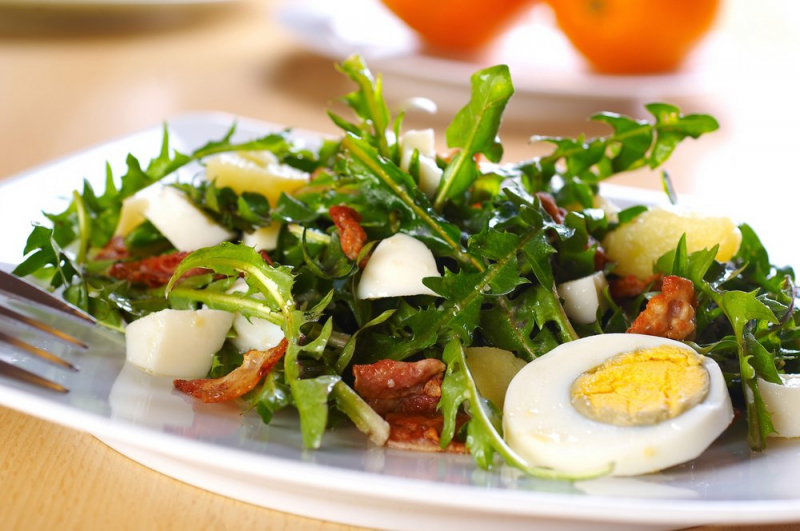
okusno.je 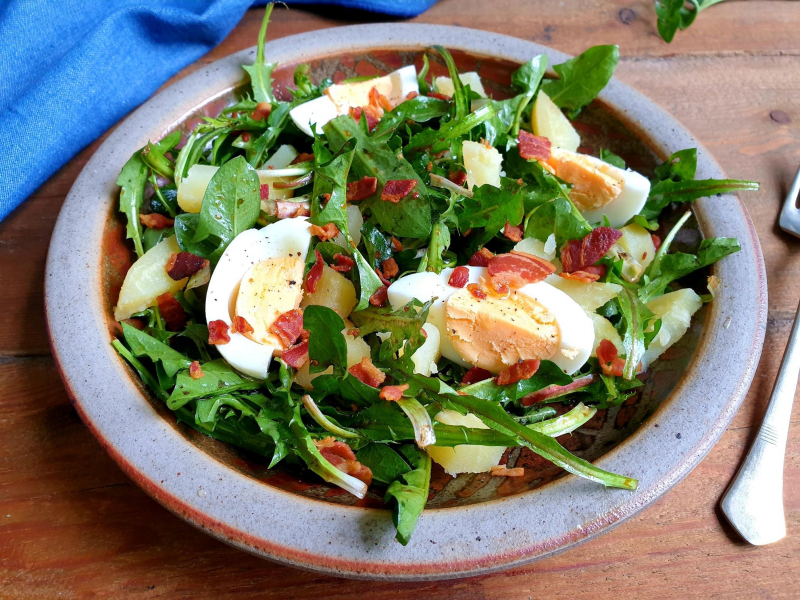
beansandsardines.com












